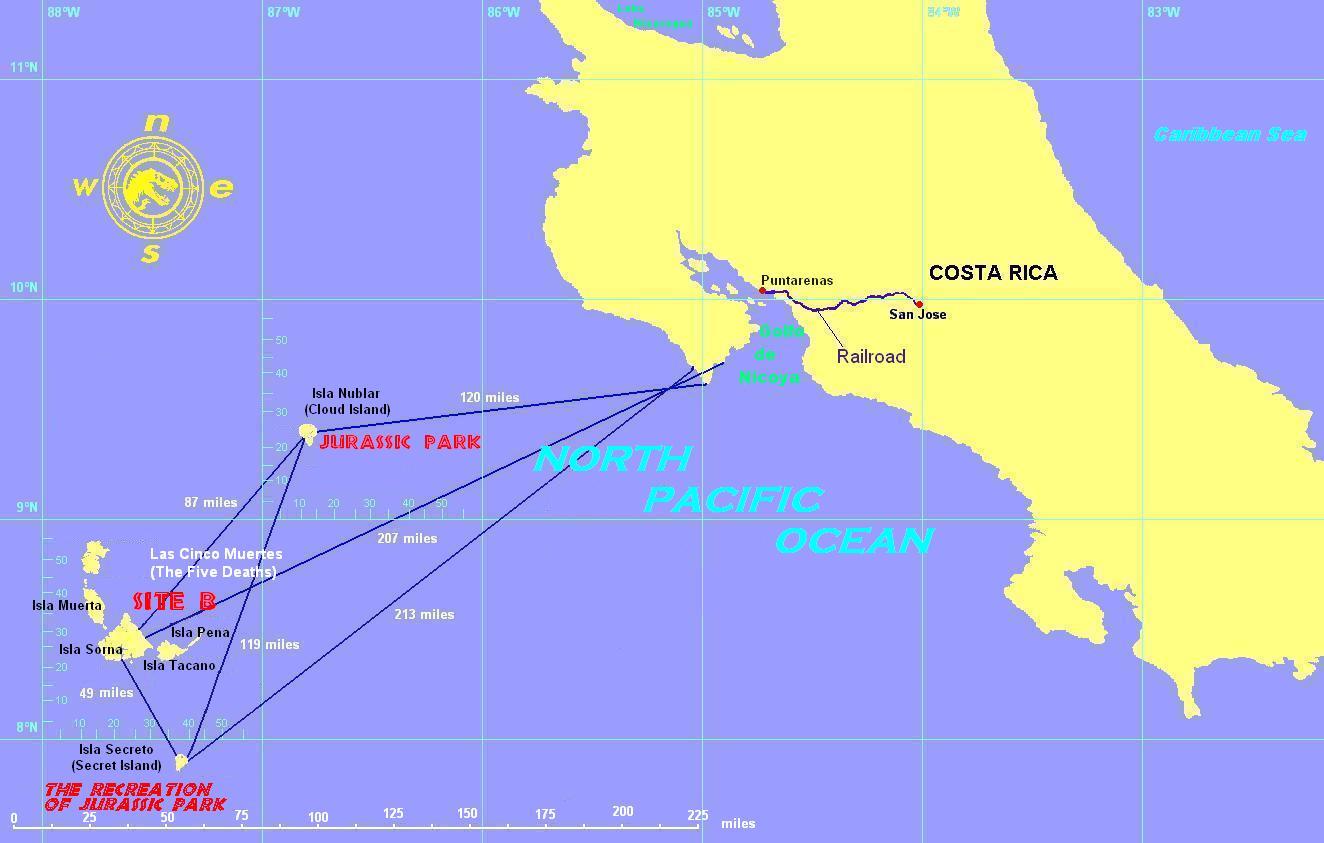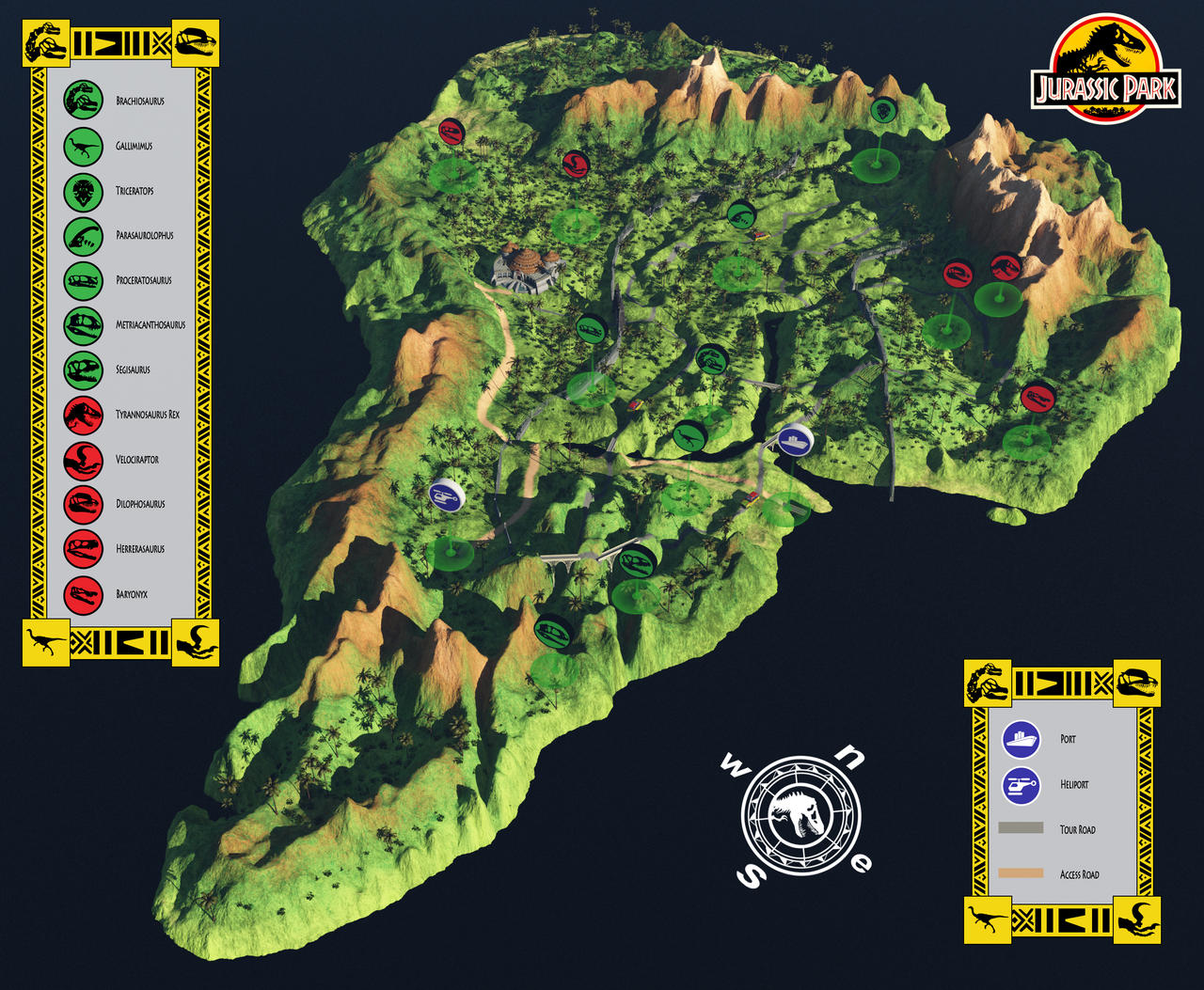The Lost World: Jurassic Park II’s Fictional Map of Costa Rica: A Detailed Exploration
Related Articles: The Lost World: Jurassic Park II’s Fictional Map of Costa Rica: A Detailed Exploration
Introduction
In this auspicious occasion, we are delighted to delve into the intriguing topic related to The Lost World: Jurassic Park II’s Fictional Map of Costa Rica: A Detailed Exploration. Let’s weave interesting information and offer fresh perspectives to the readers.
Table of Content
The Lost World: Jurassic Park II’s Fictional Map of Costa Rica: A Detailed Exploration

The 1997 film "The Lost World: Jurassic Park" captivated audiences with its thrilling portrayal of a second, hidden island teeming with cloned dinosaurs. This fictional island, known simply as "Isla Sorna" in the film, was envisioned as a remote and unexplored location within the Costa Rican archipelago. While the film’s portrayal of Isla Sorna was entirely fictional, it generated significant interest in the potential for such an island to exist and the implications for biodiversity and conservation. This article will delve into the fictional map of Isla Sorna, analyzing its features, implications, and the impact it has had on the real-world understanding of Costa Rica’s rich biodiversity.
Isla Sorna: A Fictional Island of Enormous Proportions
The film presents Isla Sorna as a vast, rugged island with a diverse landscape encompassing dense jungles, towering mountains, and treacherous ravines. This diverse topography provided the perfect setting for the film’s dramatic action sequences, showcasing the dinosaurs’ ability to navigate and hunt in various environments. While the film doesn’t provide precise measurements, Isla Sorna appears to be significantly larger than the original Isla Nublar, the island featured in the first film.
Key Features of the Isla Sorna Map:
- The InGen Compound: The film depicts a large, abandoned research facility, reminiscent of the original Jurassic Park complex on Isla Nublar. This compound served as the initial hub for InGen’s dinosaur breeding program on Isla Sorna.
- The Dinosaur Habitats: The island is home to various dinosaur enclosures, ranging from sprawling open-air paddocks to more contained environments. These enclosures are strategically placed throughout the island, reflecting the specific needs of each dinosaur species.
- The River: A prominent river flows through the center of the island, providing a vital water source and a crucial transportation route for both humans and dinosaurs.
- The Volcano: A dormant volcano looms over the island, adding to its dramatic and imposing landscape. This volcanic activity is suggested as a potential source of geothermal energy for the InGen compound.
The Significance of Isla Sorna’s Map in the Film
The map of Isla Sorna plays a crucial role in the film’s narrative. It provides a visual representation of the island’s complex ecosystem and serves as a guide for the characters’ perilous journey. The map highlights the interconnectedness of the island’s various environments and the potential dangers posed by the dinosaurs inhabiting them.
The Impact of Isla Sorna on Real-World Perceptions of Costa Rica
While Isla Sorna is fictional, its portrayal in the film has had a tangible impact on real-world perceptions of Costa Rica. The film’s depiction of a remote and untamed island filled with prehistoric creatures has sparked curiosity and fascination with Costa Rica’s biodiversity.
Real-World Biodiversity and Conservation in Costa Rica
Costa Rica is renowned for its exceptional biodiversity, with a vast array of ecosystems, including rainforests, cloud forests, and coastal areas. The country boasts a significant number of endemic species, highlighting the importance of conservation efforts.
The Role of the "Lost World" Map in Promoting Conservation
While the film’s portrayal of Isla Sorna is fictional, it has inadvertently contributed to raising awareness about the importance of conservation efforts in Costa Rica. The film’s success has sparked interest in the country’s natural wonders, potentially leading to greater appreciation for its diverse ecosystems and the need to protect them.
FAQs Regarding the "Lost World" Map:
1. Is Isla Sorna a Real Island?
No, Isla Sorna is a fictional island created for the film "The Lost World: Jurassic Park." There is no evidence of such an island existing within the Costa Rican archipelago.
2. What is the Significance of the InGen Compound on Isla Sorna?
The InGen compound represents the hub of InGen’s dinosaur breeding program on Isla Sorna. It serves as a reminder of the company’s ambition and the potential dangers associated with genetic engineering.
3. How Does the Map of Isla Sorna Reflect the Island’s Ecology?
The map showcases the diverse landscape of Isla Sorna, highlighting the interconnectedness of its various ecosystems and the potential impact of human interference on the delicate balance of nature.
4. How Did the Film’s Portrayal of Isla Sorna Impact Real-World Perceptions of Costa Rica?
The film’s portrayal of a remote and untamed island filled with dinosaurs has sparked interest in Costa Rica’s biodiversity and potentially contributed to a greater appreciation for its natural wonders.
5. What are the Real-World Conservation Efforts in Costa Rica?
Costa Rica has a strong commitment to conservation, with a significant portion of its land area dedicated to national parks and protected areas. These efforts aim to protect the country’s diverse ecosystems and ensure the long-term survival of its endemic species.
Tips for Understanding the "Lost World" Map:
- Focus on the Island’s Topography: Pay attention to the island’s diverse landscape, including its mountains, rivers, and jungles, as they play a significant role in the film’s narrative.
- Consider the Location of the InGen Compound: The compound’s placement reflects InGen’s strategic approach to managing the dinosaur population on Isla Sorna.
- Analyze the Dinosaur Habitats: The distribution of the dinosaur enclosures provides insight into the specific needs of each species and the potential risks associated with their proximity to each other.
- Explore the Symbolism of the Volcano: The volcano represents the island’s dramatic and potentially dangerous landscape, highlighting the forces of nature at play.
- Compare and Contrast Isla Sorna with Isla Nublar: Consider the differences between the two islands, particularly in terms of their size, landscape, and the level of human intervention.
Conclusion:
The fictional map of Isla Sorna in "The Lost World: Jurassic Park" serves as a reminder of the potential consequences of unchecked ambition and the importance of respecting the delicate balance of nature. While the island itself is fictional, its portrayal has sparked interest in Costa Rica’s real-world biodiversity and the need for conservation efforts to protect its unique ecosystems. By understanding the map’s features and implications, we can gain a deeper appreciation for the importance of responsible scientific exploration and the need to safeguard the planet’s rich biodiversity.








Closure
Thus, we hope this article has provided valuable insights into The Lost World: Jurassic Park II’s Fictional Map of Costa Rica: A Detailed Exploration. We hope you find this article informative and beneficial. See you in our next article!